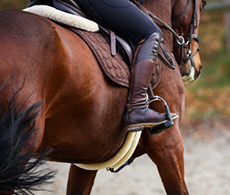
3 exercises to focus a sharp or spooky horse in winter
Expert contributor: Kate Cowell
Updated by: Suzanne Al-Gayaar
Expert checked by: Gil Riley
Does your usually calm horse become spooky on a winter evening, or struggle with pent-up energy during bad weather? Grand Prix dressage rider and trainer Kate Cowell shares her tips for staying safe and confident when riding your horse in winter.
First things first: warm up
Warm up the rider
As you’ve no doubt encountered many times before, our horses pick up on whatever we’re feeling. ‘If you’re cold, you'll feel tight,’ Kate explains. Her tip to combat this is simple: warm yourself up first. ‘A quick jog round the yard and a burst of star jumps should do the trick,’ she explains.
Warm up your horse
There are ways to help your horse feel warmer as you head out, too. ‘Warm saddle pads and quarter sheets help,’ says Kate. There’s also no harm in lunging your horse first, using a horse walker, or doing some in-hand exercises before you ride. This will help your horse warm up their muscles, relax and get them thinking forwards.
The key to happy winter schooling
Keeping your horse fit in winter while keeping sharpness and spooking to a minimum can be a challenge. So use exercises that keep your horse focused on you, and less on any distractions they might find scary. This includes the winter wind, which may be distressing for your horse, as it can inhibit their sense of hearing.
‘If your horse is distracted, avoid confrontation,’ Kate recommends. ‘Instead, you need to build their confidence. Use your three-quarter lines if they’re spooky on the track, and ride a 20m circle until they feel more secure; then gradually ride out to use the full arena.’
Also try to avoid trotting aimlessly around the school, as this won’t engage your horse’s mind and give them time to get distracted again. Mix it up with:
- Transitions. Kate recommends using a mix of direct transitions (from one pace to another, for example, walk-trot) and transitions within a pace (for example, working trot-medium trot) to get your horse listening to you. For help improving your transitions, read these tips on how to ride better transitions from Charlie Hutton.
- Stretching. Working your horse on a longer rein when they are feeling sharp might seem counterintuitive. But physical relaxation is key to keeping your horse focused and responsive to your aids, not on what’s going on around them. While you will have to work up to this, being able to stretch your horse in a longer frame, in all paces, can help to open up their spinal processes and encourage them to engage their hind end, to create that secure, forward feeling in your contact.
- Poles. Simply adding a ‘positive diversion’ to capture your horse’s attention can help them forget about tension. These polework exercises are perfect because you can set out a mixture, suitable for riding in different paces, and start using them as soon as you get on.
2022 Veterinary Awards: don’t miss your chance to nominate!
It’s never been so important to show vets our appreciation for all their hard work, so tell us about your own inspiring animal hero...
Kate suggests these three exercises to help your horse focus:
Exercise 1: Figure of eight
- In walk, ride a 15m half circle onto a diagonal line to change the rein back onto a 15m half circle the other way. If your horse is sharp, make your half circles 10m.

- In trot, start on 20m half circles with a short diagonal line in-between, so you use two-thirds of a 20x40m arena. Focus on the change of bend when changing the rein, and maintain a consistent rhythm – especially on the diagonal line. If your horse is sharp and forward, you could decrease the half circles to 15m to make them concentrate more.

- Add in a leg yield. When you’re ready to increase the level of difficulty, turn your diagonal line into a leg yield. Ride a half circle on the right rein, then on the diagonal line, leg yield to the right with slight left flexion. You’ll then have the correct bend for your half circle left. Leg yield to the left on the next diagonal line, asking your horse for a little right flexion.
Exercise 2: Canter exercise
It’s often easiest to canter when your horse is feeling fresh, as that way you can develop a good rhythm and get them softer over the back more quickly. So use this to your advantage!
- In canter, spiral in and out on a circle. To make this exercise more testing, try changing your horse’s flexion slightly to the outside when you spiral in, and to the inside when you spiral out.

- Once you’ve ridden these spirals and are feeling confident, try riding canter loops down the long side of the arena. Instead of riding one big 10m loop, see if you can ride two smaller loops each 3m in from the track.

- Next, ride a circle in-between your two loops, at either the E or B markers on the long sides of the arena.

Exercise 3: Lateral work in trot
Start in trot on a 20m circle, ride a spiral in until you are on a 12m circle, and then leg yield back out until you are back on the 20m circle. Use your inside leg to encourage the horse out onto the bigger circle, and make sure you maintain the contact with your outside rein.
Once you feel your horse is really listening to you and not distracted, go large around the arena on the left rein while riding a shoulder in. Ask for just a little inside flexion, use your inside leg to ask your horse to move laterally, with their inside hind leg following the line of the outside foreleg.
If this is a new movement for your horse, this will probably be enough to keep their brain engaged. Pause here and get comfortable with a shoulder in before you move on. Don’t expect perfection in one session.
Once your shoulder in is established (aim for 20m of shoulder in), leg yield left to the centre line. Once you are on the centre line, shoulder in right. This exercise can also be reversed and carried out on the other rein.

For more fun exercises and schooling ideas, check out our Improve Your Performance with Poles page. Not sure where to start? Have a go at the exercise of the month, follow us on Facebook and let us know how you get on!


